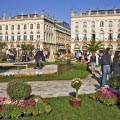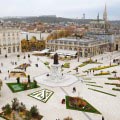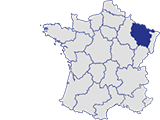





The Region
The imposing and contrasting highland landscape of the Vosges Mountains impresses its visitors by alpine heights, deep valleys, picturesque thick forests and small hidden crystal-clear lakes. Here nature has created a paradise for hiking, climbing and cycling. Situated in the northeast of France, the Vosges unite the unique mountain areas of three districts: Alsace, Lorraine and Burgundy. With the Parc des Vosges du Nord and the Parc des Ballons des Vosges we find two wonderful wildlife parks in these highlands. Countless designated paths lead the visitor across the mountains down to green valleys along sparkling streams into deep dark forests.
Read More / Weiter Lesen »
Culture & Sights
Lorraine has five towns with beautiful thermal baths to offer, and on the rivers and canals of the region individual river tourism attracts many an amateur captain from all over Europe. The capital and also the economic centre of Lorraine is Metz. The beautiful historic city of Metz with its church “St-Pierre-aux-Nonnains” is the site of one of the oldest well-preserved churches of France. In the northwest of the region lies Verdun, the scene of bloody battles during the 1st World War. The traces of the war are still to be seen in the neighbourhood of Verdun, which in 1987 was distinguished as the “world capital of peace, liberty and human rights” by the UNO. Nancy, the former capital of Lorraine, lies in the centre of the region. It is known for its “Place Stanislas”, “Place de la Carrière” and “Place d’Alliance”, which have become part of the UNESCO World Heritage in 1983. Bar-le-Duc, situated in the western part of Lorraine, is known for its well-preserved Renaissance buildings. In the most southern part of the region we find Épinal, the hometown of the cartoons.
Cuisine
Quiche Lorraine is one the favourite dishes of the French and is a popular speciality and has become known even outside Lorraine and France. The cuisine is hefty and traditional.
The Country and its People
From time immemorial have the southern, central and western parts of Lorraine belonged to the area of French, and the northeastern of German. French, imposed by France to the German population in northeast Lorraine as the official language and the language of teaching, has in the meantime largely replaced German (Middle Franconian dialects).







